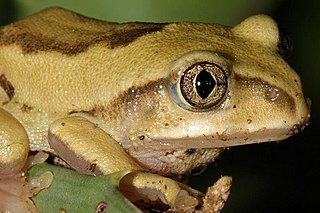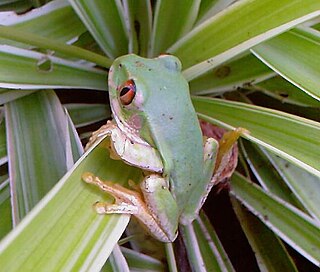
Leptopelis is a genus of frogs in the family Arthroleptidae. They are found throughout Sub-Saharan Africa, excluding Madagascar. It is placed in monotypic subfamily Leptopelinae, although this subfamily is not always recognized. They have a number of common names, including forest treefrogs, tree frogs, leaf-frogs, and big-eyed frogs.

Morelet's tree frog, also known as black-eyed leaf frog and popeye hyla, is a species of frog in the subfamily Phyllomedusinae. It is found in Belize, El Salvador, Guatemala, Honduras, and Mexico.

Leptopelis aubryi, also known as the Aubry's tree frog and Gaboon forest treefrog, is a species of frog in the family Arthroleptidae. It is found in southeastern Nigeria, Cameroon, Central African Republic, Equatorial Guinea, Gabon, Republic of the Congo, western and northern Democratic Republic of the Congo, and Angola.
Bocage’s tree frog is a species of frog in the family Arthroleptidae. It is found in Angola, Burundi, Cameroon, Democratic Republic of the Congo, Ethiopia, Kenya, Namibia, Rwanda, Tanzania, Zambia, and Zimbabwe, and possibly Botswana, Central African Republic, Chad, Malawi, Mozambique, Nigeria, Sudan, and Uganda.

Leptopelis broadleyi is a species of frog in the family Arthroleptidae of uncertain status. The Amphibian Species of the World, the IUCN SSC Amphibian Specialist Group, and the African Amphibians do not recognize it, but instead consider it synonym with Leptopelis argenteus. However, the AmphibiaWeb recognizes it as a valid species.
The Zaire forest tree frog is a species of frog in the family Arthroleptidae endemic to the Democratic Republic of the Congo. Its natural habitats are rivers, freshwater marshes, and intermittent freshwater marshes.

Leptopelis flavomaculatus is a species of frog in the family Arthroleptidae. It is found in the lowlands eastern and southern Africa, from Mozambique north of the Save River and Zimbabwe to Malawi, eastern Tanzania, and coastal Kenya. Its common names are yellow-spotted tree frog, brown-backed tree frog, brown forest treefrog, and Johnston's treefrog.
Leptopelis jordani is a species of little-known frog in the family Arthroleptidae. Common name Congulu forest treefrog has been coined for it.
Leptopelis karissimbensis is a species of frog in the family Arthroleptidae. It is found in the highlands of western Rwanda and southwestern Uganda and in the adjacent eastern Democratic Republic of the Congo. It is very similar to Leptopelis kivuensis and has been confused with that species. Common names Karissimbi forest treefrog and Karissimbi tree frog have been coined for it.

Leptopelis macrotis, sometimes called the big-eyed forest tree frog, is a species of frog in the family Arthroleptidae. It is found in the rainforests of Sierra Leone, southern Guinea, Liberia, Ivory Coast, and southern Ghana. Notice that similar common name "big-eyed tree frog" is sometimes used for Leptopelis vermiculatus from Tanzania and for Litoria exophthalmia from New Guinea.
Leptopelis modestus is a species of frog in the family Arthroleptidae. Its common names are modest forest treefrog and plain tree frog.

Leptopelis mossambicus, the brown-backed tree frog, Mozambique tree frog or Mossambique forest treefrog, is a species of frog in the family Arthroleptidae found in Eswatini, Malawi, Mozambique, South Africa, Zimbabwe, and possibly Botswana. Its natural habitats are dry savanna, moist savanna, subtropical or tropical moist shrubland, subtropical or tropical dry lowland grasslands, subtropical or tropical seasonally wet or flooded lowland grasslands, swamps, freshwater marshes, and intermittent freshwater marshes. It is threatened by habitat loss.

The Natal forest tree frog is a species of frog in the family Arthroleptidae, subfamily Leptopelinae, and is endemic to the eastern coastal area of South Africa. A typical tree frog, it has large eyes and a broad mouth. Its colouration is highly variable: Some may be bright green, others cream coloured, and some may be cream with olive-green blotches.
The common forest tree frog is a species of frog in the family Arthroleptidae found in Angola, Cameroon, the Republic of the Congo, the Democratic Republic of the Congo, Equatorial Guinea, Gabon, Nigeria, and possibly the Central African Republic. Its natural habitats are subtropical or tropical moist lowland forest, subtropical or tropical moist montane forest, subtropical or tropical high-altitude grassland, rivers, intermittent freshwater marshes, and heavily degraded former forests.

The Tai forest tree frog is a species of frog in the family Arthroleptidae. It is found in Liberia, southern Ivory Coast, and Ghana. Records from Nigeria are controversial and may refer to other species, possibly Leptopelis boulengeri.
The Kala forest tree frog, Leptopelis omissus, is a species of frog in the family Arthroleptidae found in Cameroon, the Republic of the Congo, Gabon, and Nigeria, and possibly Angola, the Central African Republic, the Democratic Republic of the Congo, and Equatorial Guinea. Its natural habitats are subtropical or tropical moist lowland forest, rivers, swamps, freshwater marshes, and heavily degraded former forests. It is threatened by habitat loss.

The palm forest tree frog is a species of frog in the family Arthroleptidae which is endemic to Príncipe island in São Tomé and Príncipe. Red tree frog Leptopelis rufus from the African mainland was for a long time included in this species, but is now considered a distinct species.
Leptopelis parbocagii, also known as Lake Upemba forest treefrog or cryptic tree frog, is a species of frog in the family Arthroleptidae. It is found in Angola, the Democratic Republic of the Congo, Malawi, Mozambique, Tanzania, and Zambia. The specific name parbocagii refers to its similarity to Leptopelis bocagii.

The Uluguru forest tree frog or ruby-eyed tree frog is a species of frog in the family Arthroleptidae endemic to Tanzania. Its natural habitats are subtropical or tropical moist lowland forest, subtropical or tropical moist montane forest, rivers, and intermittent freshwater marshes. It is threatened by habitat loss.
The long-toed tree frog is a species of frog in the family Arthroleptidae found in South Africa and possibly Lesotho. Its natural habitats are temperate grassland, swamps, freshwater marshes, and intermittent freshwater marshes.










